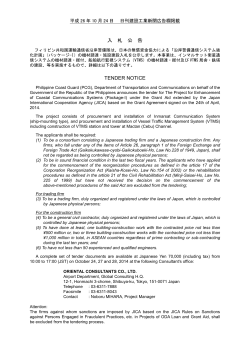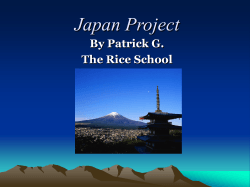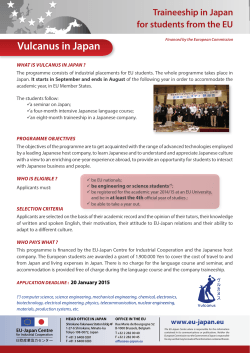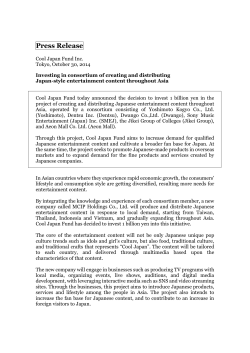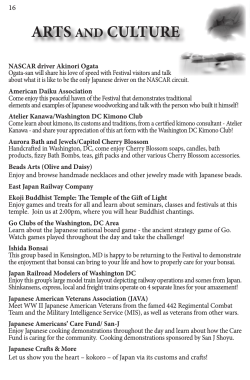
4. Overview of the Strategy for the Global Food Value Chain
機密性○情報 ○○限り Provisional Translation The Strategy for the Global Food Value Chain Promote “Made WITH Japan” through Public-Private Partnership- March 2015 Contents 1. The Size of Global Food Market 2. Establishment of the Global Food Value Chain 3. The Joint Working Group on the Strategy for the Global Food Value Chain 4. Overview of the Strategy for the Global Food Value Chain 5. The Public-Private Council for Promoting the Global Food Value Chain 6. The 1st High-Level Dialogue Meeting on Japan-Vietnam Agricultural Cooperation 7. The 1st High-Level Meeting on Japan-Myanmar Cooperation Dialogue for the Development of Myanmar’s Agriculture, Forestry, Fisheries and Foods 8. Progress on Establishing Food Value Chains between Japan and ASEAN 9. The 1st Japan-Brazil Dialogue on Agriculture and Food Contact Us: International Policy Planning Division Email: gfvc_maff@nm.maff.go.jp Tel: +81-3-3591-2657 1. The Size of Global Food Market ◆ The size of global food market (excluding Japan) is predicted to expand from 340 trillion yen (3.6 trillion USD) in 2009 to 680 trillion yen (7.2 trillion USD) in 2020*1. 2009 2020 Food market size in the world (excluding Japan) 340 trillion yen (3.6 trillion USD) 680 trillion yen (7.2 trillion USD) Source:*1 The numbers were estimated by MAFF based on AT Kearney’s data. The average exchange rate in 2009. 1 USD= 94.6 Yen 1 Provisional Translation 2. Establishment of the Global Food Value Chain The Food Value Chain -Convey the value created by producers through to consumersManufacturing &Processing Production ・Horticultural farming centers ・Farming machines and seeds ・Agricultural infrastructure ( e.g. irrigation) ・Food industrial parks ・Food manufacturing facilities Overseas business development of the Japanese food industry Distribution Consumption ・High-end cold chains ・Cold distribution centers ・Japanese-style CVS, supermarkets, department stores ・Japanese restaurants Effective utilization of economic assistance Promotion of tasty Japanese food export 2 3. The Joint Working Group on the Strategy for the Global Food Value Chain ◆ Representatives from food-related private companies, academia, local government, and central government and related organizations established “The Joint Working Group on the Strategy for the Global Food Value Chain” on April 25, 2014, for the purpose of discussing a strategy to establish food value chains* through Public-Private Partnership by utilizing the unique strengths of the Japanese food industry. *A food value chain means a whole series of activities that create, maintain and add products value, ranging from agricultural production, manufacturing, processing, distribution to consumption. ◆ This Joint Working Group finalized “the Strategy for the Global Food Value Chain” on June 6 after its 4th meeting. Development The 1st meeting on April 25 Members agreed terms of reference of the Joint WG. MAFF, JETRO, JIRCAS and Professor Dr. Itagaki presented cases on the establishment of the GFVC. The 2nd meeting on May 15 Mizuho Bank, Ltd., House Foods Corp., FUJI OIL CO., LTD., MAYEKAWA MFG. CO., LTD., Marubeni Corporation and JASTA presented cases on the establishment of the GFVC. The 3rd meeting on May 22 AEON CO., LTD., Kubota Corporation, KOKUBU & CO., LTD., ZEN-NOH, NIPPON EXPRESS Co., Ltd., NEXI and Hokkaido Government presented cases on the establishment of the GFVC. The 4th meeting on May 30 KAWASHO FOODS CORPORATION, MOS FOOD SERVICES, INC., YOSHINOYA HOLDINGS CO., LTD presented cases on the establishment of the GFVC. Members discussed the draft of the Strategy for the GFVC. “The Strategy for the Global Food Value Chain” was finalized on June 6. 3 Provisional Translation 4. Overview of the Strategy for the Global Food Value Chain -Promote “Made WITH Japan” through Public-Private Partnership- 1. Objectives Establish food value chains from production to consumption through Public-Private Partnership by utilizing the unique strengths of the Japanese food industry while the world food market is rapidly growing By establishing food value chains, i) Promote economic growth in developing countries in collaboration with economic assistance; ii) Promote overseas business and investments of the Japanese food industry; and iii) Enhance export of Japanese food-related infrastructures and create good business environment for Japanese food export. 2. The Basic Strategy Develop the strategic Public-Private Partnership Establish a framework such as bilateral policy dialogue with partner countries and public-private council Utilize the economic assistance strategically Develop food-related infrastructure such as cold chains in export markets Create favorable business and investment environment for the Japanese food industry Strengthen the information-gathering system Develop human resources both inside and outside Japan Develop the research and technology Facilitate the financing for overseas business 3. The Region-Specific Strategy Establish food value chains in the following 7 regions and countries which have high potentials for private sectors’ investments through PublicPrivate Partnership. ASEAN Middle East China India Africa Central and South America Russia and Central Asia 4 <FVC Concept 1> Establish food value chains by improving Food Industrial Parks and Cold Chains Establish high-value-added food value chains by improving high-quality farming centers, food industrial parks, cold chains etc., by utilizing the industrial and distribution networks. Develop food-related infrastructure and market-oriented structures of Japanese food export based on the needs of Japanese firms overseas. A food value chain -convey the value created by producers through to consumersManufacturing &Processing Production Horticultural farming centers Farming machines, seeds Agricultural infrastructure (e.g. Irrigation) Food industrial parks Food processing facilities Consumption Japanese-style CVS, GMS, shopping malls Japanese restaurants Export to third countries Distribution High-end cold chains Utilization of industrial and distribution networks* Overseas business development of the Japanese food industry Strategic utilization of economic assistance Promotion of Japanese food export ※ * East-West and Southern Corridors in ASEAN, Smart Knowledge and Agriculture Corridor (SKAC); Delhi Mumbai Industrial Corridor (DMIC) 5 <FVC Concept 2> Establish food value chains by introducing Japanese Advanced Technologies Establish high value-added food value chains through PPP by improving high-quality farming centers, food industrial parks and cold chains with Japanese advanced technologies such as dry & cold weather farming, irrigation, ICT, plant factories and quality control system. Create favorable business environment and develop market-oriented structures for Japanese food export through Japanese firms overseas. A food value chain -convey the value created by producers through to consumersProduction High-quality farming centers Dry & cold weather farming technologies, irrigation, ICT, plant factories Agricultural infrastructure (e.g. Irrigation) Manufacturing &Processing Food industrial parks Food processing facilities Quality control technologies Overseas business development of the Japanese food industry and introduction of Japanese advanced technologies Distribution Consumption High-end Cold chains Temperaturecontrolled distribution centers Freshness-keeping technologies Japanese-style CVS, GMS, department stores Japanese restaurants Export to third countries Strategic utilization of economic assistance Promotion of Japanese food export and development of marketoriented export structures 6 <FVC Concept 3> Establish food value chains for Halal Foods Establish food value chains of halal food from Malaysia (Kuala Lumpur) and UAE (Dubai) as a gateway Connect “Halal Hubs” such as Kuala Lumpur and Dubai, and “Singapore Hub for Japanese food” to promote export of halal foods made in/by Japan. Also promote for private companies to get Halal Certificates. Europe Halal Food Market (65 trillion Yen*) (687billion USD) (ASEAN, Middle East, North Africa, Europe, others) Middle East North Africa Export Halal Food made in/by Japan Develop production distribution and marketing networks for Halal food -Convey the value created by producers through to consumers- <UAE(Dubai)> Middle East Hub (Halal Hub) * Source: Marubeni corporation 1 yen=USD94.6 <Malaysia (Kuala Lumpur)> Halal Hub ASEAN <Singapore> Japanese Food Hub 7 <FVC Concept 4> Establish food value chains in collaboration with TICAD and Foreign Direct Investment ~Transform subsistent agriculture to market-oriented agriculture - farming as business~ Establish high-value-added food value chains through increasing agricultural production, decreasing production cost, promoting high-value-added agriculture and innovation in collaboration with TICAD and FDI. Transform subsistent agriculture to market-oriented agriculture, promote the export to third countries and increase economic growth and farm income in developing countries. A food value chain - convey the value created by producers through to consumers Manufacturing &Processing Production Farming centers (Cacao, Soybean, Sesame, Flower, Rice, etc.,) Farming machines, seeds Agricultural infrastructure (e.g. Irrigation) Food processing facilities Packaging facilities Quality control technologies Overseas business development of the Japanese food industry Distribution Consumption Distribution facilities Storage facilities Ports and airports Retail shops and markets Japanese retailers and restaurants Export to the third countries Strategic utilization of economic assistance (TICAD V) Promotion of Japanese food export TICAD V Initiative (Yokohama Action Plan 2013-2017) 1. Double rice production in Sub-Sahara Africa to 28 million tons by 2018(CARD) 2. Transform subsistence agriculture to market-oriented agriculture in 10 countries. Capacity building of 1,000 skilled agricultural trainers. Organize small farmers cooperatives for 50,000 people. 8 Provisional Translation 5. The Public-Private Council for Promoting the Global Food Value Chain 1. History The Public-Private Council was launched on June 20, 2014 for implementing “the Strategy for the Global Food Value Chain”. 2. Members (as of February 24, 2015) Private Companies (118) Related Organizations (25) Academia (5) Local Governments (18) Central Government (the Cabinet Office and Ministries) (7) [173 in total] ASEAN task force meeting was held on July 31, 2014 3. Activities (1) The Council mainly works on the following activities to establish food value chains through Public-Private Partnership: (i) Gathering, analysis, sharing and transmission of information which contributes to the establishment of food value chains (ii) Collaboration and coordination of research, mission dispatching, project formulation, etc. (iii) Creating favorable environments for overseas business and investment development by the Japanese food industry (2) Under the Council, country/region-specific task forces to strengthen the activities in each country and/or region and study groups to explore possibilities to solve common issues in countries/regions are formed. 9 6. The 1st High-Level Dialogue Meeting on Japan-Vietnam Agricultural Cooperation 1. Overview Taking the opportunity of the visit of H.E. Mr. Sang, President of Vietnam, to Japan, the basic consensus had been agreed between Japanese and Vietnamese agricultural ministers on March 2014. Based on the consensus, the first High Level Meeting of JapanVietnam Agricultural Cooperation Dialogue was held in Hanoi, Vietnam on 26th June, 2014. The representatives of 11 Japanese private companies, JICA, JETRO and the Embassy of Japan in Vietnam attended the dialogue. It was confirmed that both sides would collaborate to form a medium-long term vision for establishing food value chain in Vietnam(establishment of model areas/five-year plan), aiming for its approval by the 2nd High Level Meeting to be held in June, 2015. 2. Participants Japan: Mr. Hayashi, Minister of Agriculture, Forestry and Fisheries (cochair), Japanese Ambassador to Vietnam, JICA(Japan International Cooperation Agency), JETRO( Japan External Trade Organization), representatives from Japanese private companies and organizations* * Acecook Co., LTD., Cool Japan Fund Inc., DREAM INCUBATOR INC., ITCommunications, Inc., ISEKI & CO., LTD., Kubota Corporation, MAYEKAWA MFG. CO., LTD., JAMMA, Mitsui & Co. Ltd., Salad Bowl Co., Ltd., Sojitz Corporation Vietnam: Mr. Phat, Minister of Agriculture and Rural Development (cochair), IPSARD(Institute of Policy and Strategy for Agriculture and Rural Development), Vice-ministers of relevant ministries, representatives from Provincial People’s Committee, representatives from and the Public Corporations 10 7. The 1st High-Level Meeting on Japan-Myanmar Cooperation Dialogue for the Development of Myanmar’s Agriculture, Forestry, Fisheries and Foods 1. Overview The 1st High-Level Meeting on Japan-Myanmar Cooperation Dialogue for the Development of Myanmar’s Agriculture, Forestry, Fisheries and Foods was held in Nay Pyi Taw, Myanmar, on 23 September 2014. The Representatives of 14 Japanese private companies, JICA, JETRO and the Embassy of Japan in Myanmar attended the meeting. Both sides confirmed that they would collaborate and explore concrete actions to establish food value chains in Myanmar. 2. Participants Japan: Mr. Nishikawa, Minister of Agriculture, Forestry and Fisheries (co-chair), Japanese Ambassador to Myanmar, JICA, JETRO, representatives from Japanese private companies and organizations* * Cool Japan Fund Inc., ISEKI & CO., LTD., Japan Agricultural Machinery Manufacturers Association, Kokubu & Co., Ltd., KUBOTA Corporation, MAYEKAWA MFG. CO., LTD., Marubeni Corporation, Mitsui & Co. Ltd., NIPPON EXPRESS CO., LTD., Nippon Koei Co., Ltd., SATAKE CORPORATION, Sompo Japan Nipponkoa Insurance Inc., Sumitomo Mitsui Banking Corporation, YANMAR Co., Ltd. Myanmar: Mr. U Myint Hlaing, Union Minister for Agriculture and Irrigation (co-chair), Mr. U Win Myint, Union Minister for Commerce, Myanmar Federation of Chambers of Commerce and Industry, Myanmar Rice Federation and etc. 11 8. Progress on Establishing Food Value Chains between Japan and ASEAN Implementation Plan of the Vision Statement on ASEAN-Japan Friendship and Cooperation was adopted at the ASEAN-Japan Commemorative Summit Meeting held in Tokyo on December 14, 2013. The Plan contains the following measure: “Promote cooperation on food value chain from farmers to consumers by collaborating between public and private sector”. Vietnam The 1st High-Level Dialogue Meeting on Japan-Vietnam Agricultural Cooperation (June 26, 2014 in Hanoi, Vietnam) see p6 and p7 Myanmar The 1st High-Level Meeting on Japan-Myanmar Cooperation Dialogue for the Development of Myanmar’s Agriculture, Forestry, Fisheries and Foods (September 23, 2014 in Naypyidaw, Myanmar) see p8 The 36th Meeting of the ASEAN Ministers on Agriculture and Forestry (36th AMAF) (September 23, 2014 in Naypyidaw) The Ministers expressed support for Minister Nishikawa’s presentation. The Joint Press Statement contains the following: We supported the initiative on Public Private Partnership Cooperation for Establishing Food Value Chain between ASEAN and Japan, and Noted that some activities have been conducted such as the establishment of Joint Working Group consisted of representatives from food-related private companies and organizations, academia, local and central organizations and “the Strategy for Global Food Value Chain”. ASEAN ASEAN+3 The 14th Meeting of the ASEAN Ministers on Agriculture and Forestry and the Ministers of Agriculture of the People’s Republic of China, Japan and the Republic of Korea (14 th AMAF Plus Three)(September 24, 2014 in Naypyidaw) The Joint Press Statement contains the following: We noted Japan’s support on the Public Private Partnership Cooperation for Establishing Food Value Chain in some ASEAN Member States. Building on this initiative, we encouraged the initiative to be expanded to the regional level. ASEAN The 17th Japan-ASEAN Summit Meeting (November 12, 2014 in Naypyidaw) Prime Minister Abe said he wants to steadily implement the Vision Statement on ASEAN-Japan Friendship and Cooperation and the Joint Statement that were adopted at the ASEAN-Japan Commemorative Summit Meeting in December 2013, and deepen cooperation further. The Chairman’s Statement contains the descriptions to the effect that the Heads were pleased with progress of implementation of the Vision Statement and the Joint Statement. ASEAN+3 The 17th ASEAN Plus Three (Japan-China-Republic of Korea) Summit (November 13, 2014 in Naypyidaw) Prime Minister Abe expressed his intention to strengthen the public-private cooperation for “food value chain (FVC).” 12 9. The 1st Japan-Brazil Dialogue on Agriculture and Food 1. Overview Prime Minister Abe paid a visit to Brazil in August 2014, and both leaders decided to commence a public-private dialogue to deepen bilateral relations in the agriculture and food sector. Based on this decision, the 1st Japan-Brazil Dialogue on Agriculture and Food was held in San Paulo on December 8, 2014. The representatives of the relevant Ministries in both countries, 26 Japanese companies operating in Brazil which are related to the agriculture and food sector, JICA, JBIC, JETRO, and the Embassy of Japan in Brazil attended the Dialogue and discussed i)development of the agriculture and food industry in Brazil, ii)facilitation of bilateral trade, and iii)improvement of distribution. Vice-Minister Harihara and Minister Geller signed a memorandum that describes the agreement, such as holding the Dialogue annually in principal as a venue for continuous dialogues between the both governments and the private sector toward establishing food value chains in Brazil. 2. Participants Japan: Mr. Harihara, Vice-Minister of Agriculture, Forestry and Fisheries, Japanese Ambassador to Brazil, JICA(Japan International Cooperation Agency), JBIC(Japan Bank for International Cooperation), JETRO( Japan External Trade Organization), representatives from Japanese companies operating in Brazil which are related to the agriculture and food sector* * Mitsui & Co.(Brasil) S.A., Ajinomoto do Brasil Indústria e Comércio de Alimentos Ltda., ITOCHU Brasil S.A., Docomo Brasil Serviços de Telecomunicação Ltda., CAMPO Consultoria e Agronegocios Ltda., BRASIL KIRIN, Sakata Seed Sudamerica LTDA., Satake America Latina LTDA., Suntory Liquors Brasil Ltda., Sumitomo Corporation do Brasil S.A., SOJITZ DO BRASIL S.A., Chuo Kaihatsu Corporation, Tozan Farm, Nissin-Ajinomoto Alimentos, Nippon Koei LAC do Brasil Ltda., Nippon Express do Brasil Transportes Internacionais Ltda., NH Foods do Brasil, Hitachi South America Ltda., FRUTA FRUTA INC., Maekawa do Brasil Equipamentos Industriais Ltda., Marubeni Brasil S.A., Banco Sumitomo Mitsui Brasileiro S.A., Mitsubishi Corporation do Brasil, Banco de Tokyo-Mitsubishi UFJ Brasil S/A, Yakult S/A Indústria e Comércio, YANMAR SOUTH AMERICA INDUSTRIA DE MAQUINAS LTDA. Brazil: Mr. Geller, Minister of Agriculture, Mr. Junqueira, Vice-Minister of Agriculture, Mr. Rodrigues, Ex-Minister of Agriculture, Mr. Turra, Ex-Minister of Agriculture, other government officials and representatives from private companies 13
© Copyright 2025

